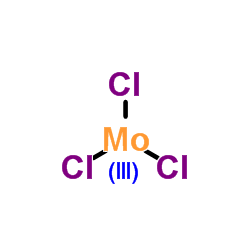Molybdenum(III) chloride

Molybdenum(III) chloride structure
|
Common Name | Molybdenum(III) chloride | ||
|---|---|---|---|---|
| CAS Number | 13478-18-7 | Molecular Weight | 202.299 | |
| Density | 3.58 g/mL at 25 °C(lit.) | Boiling Point | N/A | |
| Molecular Formula | Cl3Mo | Melting Point | 1027°C | |
| MSDS | Chinese USA | Flash Point | N/A | |
| Symbol |

GHS07 |
Signal Word | Warning | |
| Name | molybdenum trichloride |
|---|---|
| Synonym | More Synonyms |
| Density | 3.58 g/mL at 25 °C(lit.) |
|---|---|
| Melting Point | 1027°C |
| Molecular Formula | Cl3Mo |
| Molecular Weight | 202.299 |
| Exact Mass | 202.811966 |
| LogP | 2.06850 |
| Appearance of Characters | Powder | Dark red |
| Vapour Pressure | 33900mmHg at 25°C |
| InChIKey | ZSSVQAGPXAAOPV-UHFFFAOYSA-K |
| SMILES | Cl[Mo](Cl)Cl |
| Water Solubility | H2O: insoluble(lit.) | Soluble in nitric acid and sulfuric acid. Insoluble in water and dilute hydrochloric acid. Slightly soluble in ethanol and diethyl ether. |
|
Section 1: Product Identification Chemical Name:Molybdenum(III) chloride (99.5%-Mo) CAS Registry Number:13478-18-7 Formula:MoCl3 EINECS Number:236-775-9 Chemical Family:metal halide Synonym:Molybdenum trichloride
Section 2: Composition and Information on Ingredients IngredientCAS NumberPercentACGIH (TWA)OSHA (PEL) Title Compound13478-18-7100%0.5mg/m35mg/m3 Section 3: Hazards Identification Emergency Overview:Corrosive to skin, eyes and respiratory tract. Inhalation of dust leads to burning of the respiratory tract. Primary Routes of Exposure:Contact with skin and eyes. Inhalation of dust. Eye Contact:Corrosive to the eyes. Skin Contact:Causes burns to the skin. Inhalation:Inhalation of dust leads to chemical burns of the respiratory tract. Ingestion:No information is available on the physiological effects of ingestion. Acute Health Affects:Corrosive to skin, eyes and respiratory tract. Chronic Health Affects:No information available on long-term chronic effects. NTP:No IARC:No OSHA:No SECTION 4: First Aid Measures Immediately flush the eyes with copious amounts of water for at least 10-15 minutes. A victim may need Eye Exposure: assistance in keeping their eye lids open. Get immediate medical attention. Wash the affected area with water. Remove contaminated clothes if necessary. Seek medical assistance if Skin Exposure: irritation persists. Remove the victim to fresh air. Closely monitor the victim for signs of respiratory problems, such as difficulty Inhalation: in breathing, coughing, wheezing, or pain. In such cases seek immediate medical assistance. Seek medical attention immediately. Keep the victim calm. Give the victim water (only if conscious). Induce Ingestion: vomiting only if directed by medical personnel. SECTION 5: Fire Fighting Measures Flash Point:not applicable Autoignition Temperature:none Explosion Limits:none Extinguishing Medium:none required If involved in a fire, fire fighters should be equipped with a NIOSH approved positive pressure self-contained Special Fire Fighting Procedures: breathing apparatus and full protective clothing. Hazardous Combustion andnone Decomposion Products: Unusual Fire or Explosion Hazards: No unusual fire or explosion hazards. SECTION 6: Accidental Release Measures Small spills can be neutralized with powdered sodium bicarbonate, lime, or calcium carbonate and swept up. Spill and Leak Procedures:Large spills in areas not adequately ventilated will require an evacuation of site. Emergency response teams will require self-contained breathing apparatus. SECTION 7: Handling and Storage Handling and Storage:Store material in a tightly sealed container under an inert atmosphere of nitrogen or argon. SECTION 8: Exposure Controls and Personal Protection Eye Protection:Always wear approved safety glasses when handling a chemical substance in the laboratory. Skin Protection:Wear protective clothing gloves. Consult glove manufacturer to determine the proper type of glove. Ventilation:If possible, handle the material in an efficient fume hood. If in form of fine dust and ventilation is not available a respirator should be worn. The use of respirators Respirator: requires a Respirator Protection Program to be in compliance with 29 CFR 1910.134. Ventilation:If possible, handle the material in an efficient fume hood. Additional Protection:No additional protection required. SECTION 9: Physical and Chemical Properties Color and Form:-100 mesh purple xtl. Molecular Weight:202.32 Melting Point:dec. Boiling Point:no data Vapor Pressure:no data Specific Gravity:3.59 Odor:none Solubility in Water:reacts with water SECTION 10: Stability and Reactivity Stability:air sensitive, moisture sensitive Hazardous Polymerization:no hazardous polymerization Conditions to Avoid:contact with moisture Incompatibility:active metals Decomposition Products:none SECTION 11: Toxicological Information RTECS Data:Oral (insect-Drosophila melanogaster); Specific locus test: 10nmol/L. Carcinogenic Effects:no data Mutagenic Effects:Mutagen Tetratogenic Effects:no data SECTION 12: Ecological Information Ecological Information:No information available SECTION 13: Disposal Considerations Disposal:Dispose of according to local, state and federal regulations. SECTION 14: Transportation Shipping Name (CFR):Corrosive solids, N.O.S. Hazard Class (CFR):8 Additional Hazard Class (CFR):NA Packaging Group (CFR):II UN ID Number (CFR):UN# 1759 Shipping Name (IATA):Corrosive solid, N.O.S. Hazard Class (IATA):8 Additional Hazard Class (IATA):NA Packaging Group (IATA):II UN ID Number (IATA):UN# 1759 SECTION 15: Regulatory Information TSCA:Listed in the TSCA inventory. SARA (Title 313):Title compound not listed Second Ingredient:none SECTION 16 - ADDITIONAL INFORMATION N/A |
CHEMICAL IDENTIFICATION
HEALTH HAZARD DATAACUTE TOXICITY DATAMUTATION DATA
|
| Symbol |

GHS07 |
|---|---|
| Signal Word | Warning |
| Hazard Statements | H315-H319-H335 |
| Precautionary Statements | P261-P305 + P351 + P338 |
| Personal Protective Equipment | dust mask type N95 (US);Eyeshields;Gloves |
| Hazard Codes | Xi: Irritant; |
| Risk Phrases | R36/37/38 |
| Safety Phrases | S26;S37/S39 |
| RIDADR | UN3260 |
| WGK Germany | 3 |
| RTECS | QA4681400 |
| Packaging Group | III |
| Hazard Class | 8 |
|
~% 
Molybdenum(III)... CAS#:13478-18-7 |
| Literature: Ullmanns Encykl. Tech. Chem. 4th Ed., , vol. 17, p. 23 - 50 Mo: SVol.A3, 2.4.6.2, page 62 - 63 |
|
~% 
Molybdenum(III)... CAS#:13478-18-7 |
| Literature: Journal fuer Praktische Chemie (Leipzig), , vol. 71, p. 453 - 453 |
|
~% 
Molybdenum(III)... CAS#:13478-18-7 |
| Literature: Mo: SVol.A3, 2.7.27, page 182 - 183 |
|
~% 
Molybdenum(III)... CAS#:13478-18-7 |
| Literature: Chemiker-Zeitung, , vol. 12, p. 5 - 5 Mo: MVol., 56, page 162 - 164 |
|
~% 
Molybdenum(III)... CAS#:13478-18-7 |
| Literature: Journal of the Chemical Society, Dalton Transactions: Inorganic Chemistry (1972-1999), , p. 1197 - 1198 |
|
~% 
Molybdenum(III)... CAS#:13478-18-7 |
| Literature: European Journal of Inorganic Chemistry, , # 10 p. 2699 - 2703 |
|
Synthesis of highly functionalized 9,10-phenanthrenequinones by oxidative coupling using MoCl5.
Org. Lett. 14(12) , 2976-9, (2012) The strong oxidative power of molybdenum pentachloride gives rise to an efficient oxidative C-C bond formation of benzil derivatives to the corresponding 9,10-phenanthrenequinones. A highly complement... |
|
|
Genotoxic activities in vivo of cobaltous chloride and other metal chlorides as assayed in the Drosophila wing spot test.
Mutat. Res. 320(1-2) , 133-40, (1994) A series of metal chlorides were subjected to the wing spot test of Drosophila melanogaster. In the test, larvae trans-heterozygous for the wing-hair mutations mwh and flr were orally treated at the t... |
|
|
Novel domino oxidative coupling: C-C bond formation sequence to highly functionalized dibenzo[a,c]cycloheptenes.
Org. Lett. 13(5) , 916-9, (2011) A domino sequence involving various MoCl(5)-mediated oxidations followed by trapping and supposed [3,3]-sigmatropic rearrangement provides a fast access to the full carbon skeleton of metasequirin-B. ... |
| trichloromolybdenum |
| Molybdenum(III) chloride |
| MoCl3 |
| MFCD00014214 |
| molybdenum trichloride |
| EINECS 236-775-9 |
| Molybdenum(3+) trichloride |
| trichloridomolybdenum |





